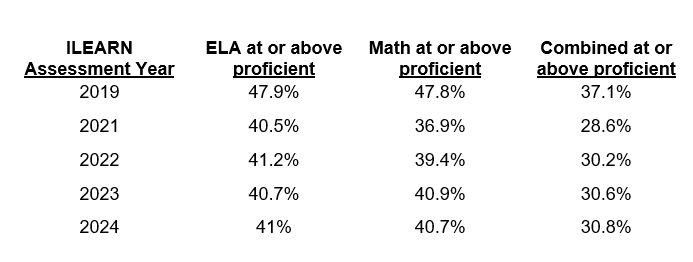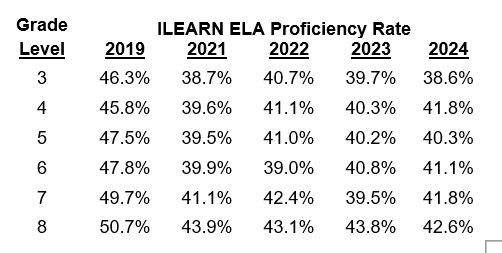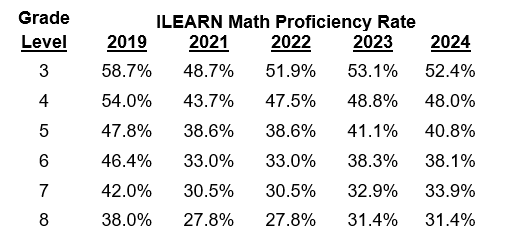Test scores sit stagnant; what’s ahead to up student progress
Different year, but essentially the same story. Indiana’s latest ILEARN results show student progress is stagnating – not sharply increasing or decreasing in the last few years, which likely signals students are still not recovering from learning losses that resulted from the Covid-19 pandemic.
The bottom line is, however, that almost 70% of students are not passing the test in both English and math.
New ILEARN scores from spring 2024 show 30.8% of Indiana students tested scored at or above proficiency standards in both English and language arts and math. While that is a slight increase from last year’s rates of 30.6%, it’s still largely stagnant. These results still also remain below pre-pandemic levels. In 2019, the first year of ILEARN, 37% of students scored proficient in both ELA and math.
Separating the two tests, ELA saw the slight gains, while math decreased. For ELA, 41% of students passed the test, which is up from 40.7% passing last year. The percentage of students at or above proficiency standards in math, on the other hand, decreased from 40.9% passing in 2023 to 40.7% in 2024.
State leaders prefer to use 2021 as a baseline, despite the fact that ILEARN began testing in 2019. In 2021, student scores plummeted in the first year of testing following a break in 2020 during the pandemic. Because of the learning disruption and ILEARN not being administered in 2020, the state prefers to compare to 2021 – and scores are up since 2021. Still, we see it fit to compare back to showcase where we were pre-pandemic for perspective.

Are these results yet another indicator that students are struggling to recoup from the pandemic learning losses? Or do we need to stop blaming the pandemic at this point?
Secretary of Education Katie Jenner contends that state leaders will continue to ask that question, and that will likely not end for a while.
“We’re going to be asking that question as a country for years to come. When you close all of your schools across the country, what is the impact?” Dr. Jenner questions.
One of the lowest passing rates is seen among third graders on the ELA test, with 38% showing proficiency. The third grade passing rate on the ELA portions has been on the decline since 2021, likely signaling these students are among those most impacted by the pandemic shutdowns. Recall these students were just starting school as schools shut down and curriculum was being taught switching between e-learning and in-person days. We also know that reading proficiency among third graders is low, as we heard about constantly during the 2024 legislative session, which also could contribute to those students struggling more on the ELA ILEARN test.

On the opposite side, eighth grade students displayed higher proficiency in ELA this year but were the lowest in math performance. State officials, however, contend it’s a common trend to see lower performance among eighth graders on ILEARN.

You’ll notice the largest percentage point jumps come in the math area, going from 36.9% of students testing proficient in 2021 to now 40.7% testing at or above proficiency. That’s showing improvement, but still, note how math scores saw the biggest drop from 2019 to 2021, compared to English.
Dr. Jenner recognizes there is work to be done, even though scores have improved since the baseline of 2021. Beyond just focuses on recouping pandemic-related learning losses, the Indiana Department of Education now understands what foundations it needs to focus on, she says.
“We know the value of foundations for students – literacy, STEM, and that’s where I think we have to stay laser focused,” Secretary Jenner asserts. “We need to make sure we are getting students reading and that we are improving in math, even though we’ve seen the most growth there over time. We have to stay laser-focused on that work.”
Change is coming, and officials hope recent moves can boost student progress. You may recall the ILEARN assessment is undergoing a significant redesign, providing schools with the option to distribute parts of the exam throughout the academic year.
The assessment strategy includes “flexible checkpoints” that allow schools to conduct preparatory ILEARN tests in English and math prior to the usual end-of-year summative tests. This model is already in use in a dozen other states.
The revamped assessment will feature three “checkpoints” and a condensed summative assessment at the conclusion of the school year. Each checkpoint will be comprised of 20 to 25 questions focusing on four to six state standards. The tests are planned to be administered to students roughly every three months, although local schools and districts have the flexibility to accelerate testing if desired.
Checkpoints will not be punitive; students who do not master a specific standard will receive further intervention and instruction before being offered a retest option.
To date, 72% of schools across Indiana have chosen to participate in a pilot of ILEARN checkpoints for the upcoming 2024-25 school year, as reported by IDOE. The comprehensive system will be implemented during the 2025-26 school year.
Dr. Jenner on Wednesday explains that the new checkpoints will offer enhanced, real-time student data that can be utilized to more effectively provide support for students throughout the year, instead of waiting until the end of the year for results, which may be “too late” for teachers to offer assistance.
Will this be enough to recoup what is still being seen as pandemic-related learning loss? We’ll have to wait another year to see the first returns on investment.
State Board of Education member Scott Bess still thinks improvement is happening too slowly. “If we keep on that trajectory, I am going to be in a home before we get any kind of acceptable results,” Bess, the head of school for Purdue University’s Polytechnic High School in Indianapolis, remarked during Wednesday’s board meeting.
We could see our gubernatorial candidates weigh in as well as we get closer to the November general election.
You shouldn’t be surprised to see gubernatorial nominee Jennifer McCormick (D), a former superintendent of public instruction and a former educator, hone in on the lack of progress in student test scores. Dr. McCormick is a staunch supporter of public schools, and she’s making that a large part of her campaign, particularly how she sees Republican lawmakers placing more focus and funding on school choice through vouchers rather than traditional public schools.
You also could see U.S. Sen. Mike Braun (R) respond as well as part of his gubernatorial campaign, given his platforms on supporting school choice and making parents stakeholders in their children’s education as playing a role in reversing learning loss. Sen. Braun, the Republican gubernatorial nominee, has also been of the opinion that it wasn’t the pandemic, but measures implemented by the state to keep schools shut down that caused learning losses.
When asked about what he would champion to get students back on track by the Indiana Capital Chronicle in April ahead of the May primary, Braun – a former elected school board member in Dubois County – didn’t provide many specifics, but drew back to his platform on parent involvement stating: “Parents are the primary stakeholder in their kids’ education. I clashed with the Biden administration’s Secretary of Education at a Senate hearing when he wouldn’t accept that simple fact, and it will be the centerpiece of my approach to education as governor.”
Up next in state assessment scores . . . we’re anxiously waiting next month when this year’s IREAD-3 results are released, especially given the “laser focus” on the state’s less-than-ideal literacy proficiency rates during the 2024 legislative session.
Though we won’t see the effects of new policies tightening retention and adding more intervention in third grade come to fruition until next year, given last year’s dismal results, this year’s results will likely show again IDOE and legislative urgency to find solutions to improve student achievement.

